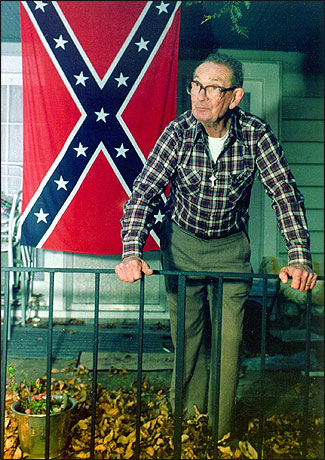See, the green house with the red flag was only miles from my own house in the tiny town of Signal Mountain, Tennessee.
That man was Byron De La Beckwith.
De La Beckwith shot and killed civil rights activist Medger Evers, a husband and father of three, with an Enfield 1917 rifle just hours after John F. Kennedy's nationally televised Civil Rights Address on June 12, 1963 in Jackson, Mississippi. A proud white supremacist, member of the White Citizens Council, and KKK Klansman, De La Beckwith was prosecuted twice for the assassination of Evers but both trials ended in hung (all white male) juries. For decades, Byron De La Beckwith was a free man and often boasted about murdering Evers at Klan meetings.
After new evidence emerged, Byron De La Beckwith was arrested in his Signal Mountain home on December 30, 1990 for the murder of Medger Evers. According to the New York Times, De La Beckwith "wore a Confederate flag on his lapel during the trial. When the jury of eight blacks and four white people returned a guilty verdict on Feb. 5, 1994, he appeared dazed, as though not sure where he was." He died in prison in 2001.
That man was Byron De La Beckwith.
 |
| Byron De La Beckwith at his home on Signal Mountain. |
De La Beckwith shot and killed civil rights activist Medger Evers, a husband and father of three, with an Enfield 1917 rifle just hours after John F. Kennedy's nationally televised Civil Rights Address on June 12, 1963 in Jackson, Mississippi. A proud white supremacist, member of the White Citizens Council, and KKK Klansman, De La Beckwith was prosecuted twice for the assassination of Evers but both trials ended in hung (all white male) juries. For decades, Byron De La Beckwith was a free man and often boasted about murdering Evers at Klan meetings.
After new evidence emerged, Byron De La Beckwith was arrested in his Signal Mountain home on December 30, 1990 for the murder of Medger Evers. According to the New York Times, De La Beckwith "wore a Confederate flag on his lapel during the trial. When the jury of eight blacks and four white people returned a guilty verdict on Feb. 5, 1994, he appeared dazed, as though not sure where he was." He died in prison in 2001.
In high school, my American History teacher showed us the film Ghosts of Mississippi, a feature film about the investigation of De La Beckwith and his eventual conviction. James Woods was even nominated for an Oscar for his hammy potrayal of De La Beckwith. He has a line where he tells a prosecutor, "Pretty soon I'mma be back in my home on Signal Mountain and there ain't nothing you can do 'bout it." At the mention of our town, most of my classmates and even my teacher cheered. I remember feeling shocked and sick at this display. I then just figured their bizarre reaction was just they were just excited about an Oscar nominated film mentioning Signal Mountain. Now that I'm older, I know better. I now know that many of those cheering kids were from racist households and cheering a little too loud and for the wrong reasons.
I have researched the history of the Confederate flag and read opinions for those that support it and I found nothing to redeem the flag or justify it being flown on government property. There will be those who will continue to display it on their own property, cars, businesses, children's clothing, and that's their right. My opinion hasn't changed since I was eight years old. I felt, and have always felt, there was something sinister about that red flag. I feel it in my gut every time I see the Confederate flag. It represents hate, division, and white privilege. Nothing, I repeat nothing, can or will redeem the Confederate flag. As a Southerner, I'm ashamed of it and I hope that we can stop celebrating it. In the words of Indiana Jones, "It belongs in a museum." Let us learn from the mistakes rather than glorify a hateful, dangerous symbol that insults and threatens so many people.
*I wrote this essay on June 24, 2015 amidst the Charleston, South Carolina shooting of nine black parishioners at Mother Emanuel African Methodist Episcopal Church. This tragic racially motivated hate crime made people finally challenge the place of the Confederate flag on government grounds. I shared this essay on Facebook and got immediate pushback. My Facebook friends declared the Confederate flag was simply about "Southern pride," a symbol for states' rights and in no way connected to slavery. I shared article after article and quotes by Frederick Douglass and others. I lost four friends that day. I was shocked. It was shocking to me because of my inherent white privilege and naivete. I had yet to learn that racism rages in the hearts of so many people. Three years later, I left The Church of Jesus Christ of Latter-Day Saints because I discovered so much racist history of that church and racism thriving in the people I went to church with. With the permission of my Bishop, I gave a talk about racism. I was openly mocked, yelled at, and literally shunned. These people had known me my entire life and just dumped me because I said, hey, "let's not be racist." Some even refused to acknowledge my existence and would look straight through me as if I was a ghost. I finally realized how disgusting this situation actually was and refused to allow my child to be taught or influenced by people like this. I left the church I was born into because I saw that these people didn't hold the same values as I did. Basic human values were a joke to them. I realized that evil wasn't trapped inside the green house with the red flag. It's everywhere.

No comments:
Post a Comment